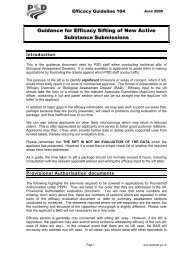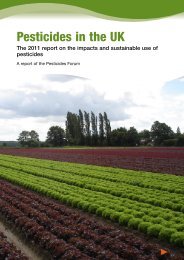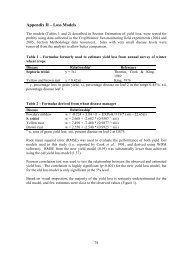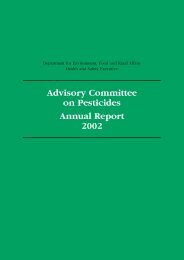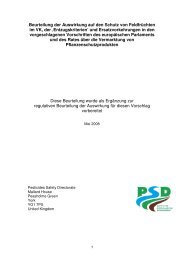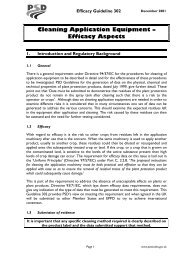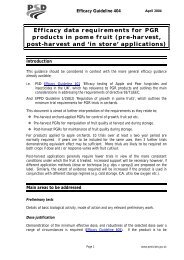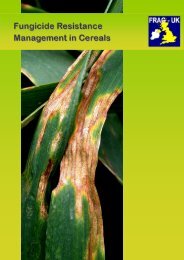Advisory Committee on Pesticides Annual Report 2001
ACP Annual Report 2001 - Pesticides Safety Directorate
ACP Annual Report 2001 - Pesticides Safety Directorate
You also want an ePaper? Increase the reach of your titles
YUMPU automatically turns print PDFs into web optimized ePapers that Google loves.
<str<strong>on</strong>g>Advisory</str<strong>on</strong>g> <str<strong>on</strong>g>Committee</str<strong>on</strong>g> <strong>on</strong> <strong>Pesticides</strong> <strong>Annual</strong> <strong>Report</strong> <strong>2001</strong><br />
Encarsia formosa and Phytoseiulus persimilis were the most extensively<br />
used biological c<strong>on</strong>trol agents <strong>on</strong> edible crops. The most extensively used<br />
fungicides were propamocarb hydrochloride, iprodi<strong>on</strong>e, fosetyl-aluminium,<br />
metalaxyl/thiram and tolclofos-methyl. The organophosphates were the most<br />
extensively used group of insecticides and were used <strong>on</strong> 36 percent of the<br />
total insecticide-treated area. The pyrethroids were used <strong>on</strong> 34 percent of the<br />
insecticide-treated area and the carbamates 19 percent. The most extensively<br />
used individual insecticides were cypermethrin, pirimicarb and heptenophos.<br />
Fenbutatin oxide was used <strong>on</strong> 42 percent of the acaricide-treated area and<br />
abamectin <strong>on</strong> 32 percent.<br />
66<br />
Although the area of edible protected crops had declined by 38 percent since<br />
1991 the area treated with registered pesticides had decreased by 52 percent.<br />
In c<strong>on</strong>trast, since 1991, the area treated with n<strong>on</strong>-registered biological c<strong>on</strong>trol<br />
agents decreased, by 42 percent, in line with changes in the area grown.<br />
Usage of registered biological c<strong>on</strong>trol agents had declined by 77 percent since<br />
1991. The areas treated with all registered pesticides had declined by<br />
26 percent, between 1995 and 1999, and in particular fungicide usage had<br />
decreased by 33 percent, insecticides by five percent, molluscicides by<br />
71 percent and herbicides by 42 percent. Only the areas treated with sulphur<br />
had increased since 1995. The weight of registered active substances applied<br />
to edible protected crops had decreased by 60 percent since 1991 and by<br />
15 percent since the last survey. Soil sterilants accounted for less than <strong>on</strong>e<br />
percent of the treated area but for 50 percent of the total weight of active<br />
substances applied.<br />
The total area of protected ornamental crops grown in 1999 was 84 percent<br />
greater than in 1995 and 34 percent greater than in 1991. With the excepti<strong>on</strong><br />
of other “flowers and foliage”, where the area grown had increased by<br />
21 percent since 1995, the areas of all other flowers for cutting had declined<br />
markedly, reflecting the increased pressure from imports. The area of pinks<br />
had declined by 55 percent, carnati<strong>on</strong>s by 40 percent, chrysanthemums<br />
by 21 percent and alstroemeria by four percent.<br />
Growth regulators accounted for 35 percent of the total area of protected<br />
ornamental crops treated for pest, disease and weed c<strong>on</strong>trol, fungicides<br />
29 percent, insecticides 26 percent, acaricides five percent, herbicides two<br />
percent, molluscicides <strong>on</strong>e percent and registered biological c<strong>on</strong>trol agents<br />
<strong>on</strong>e percent. When all biological c<strong>on</strong>trol agents were included, the level of<br />
biological c<strong>on</strong>trol increased to 15 percent of the combined total. Soil sterilants




